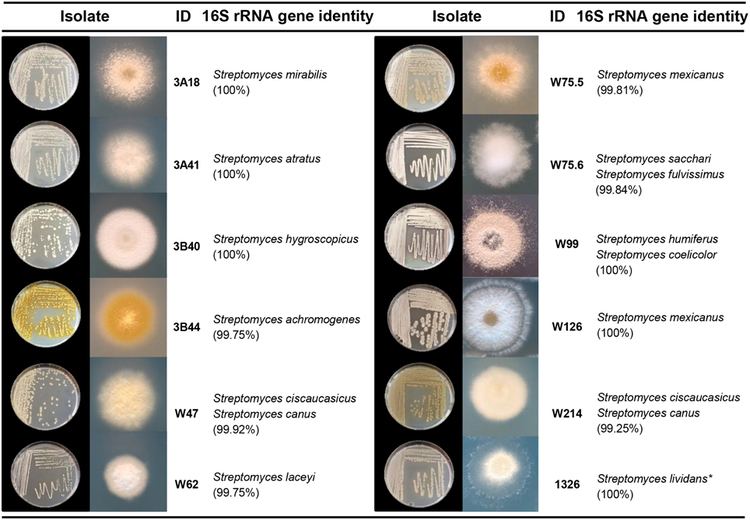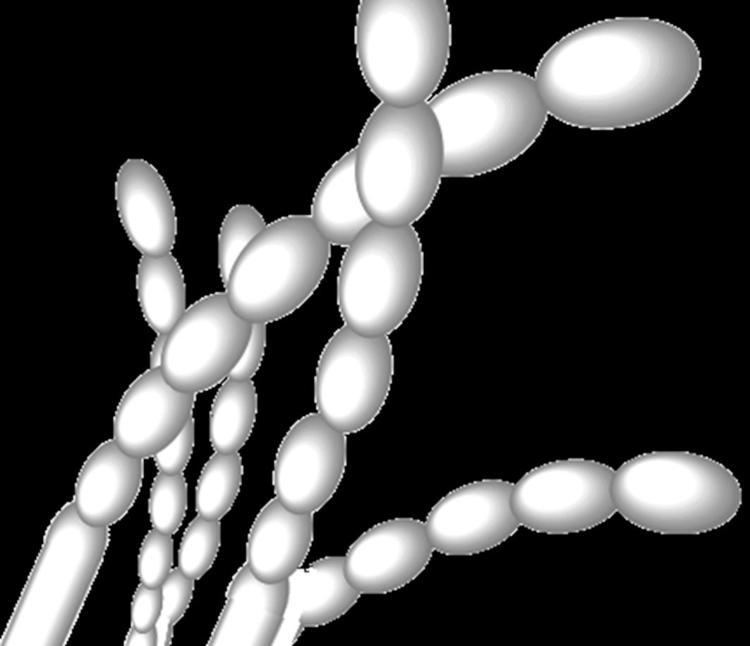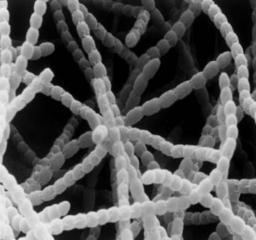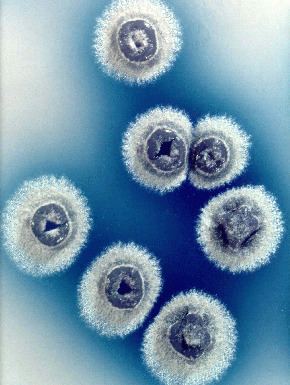Scientific name Streptomyces | ||
 | ||
Lower classifications Streptomyces griseus, Streptomyces hygroscopicus, Streptomyces clavuligerus, Streptomyces rimosus, Streptomyces globisporus | ||
Streptomyces
Streptomyces is the largest genus of Actinobacteria and the type genus of the family Streptomycetaceae. Over 500 species of Streptomyces Bacteria have been described. As with the other Actinobacteria, streptomycetes are Gram-positive, and have genomes with high GC content. Found predominantly in soil and decaying vegetation, most streptomycetes produce spores, and are noted for their distinct "earthy" odor that results from production of a volatile metabolite, geosmin.
Contents
- Streptomyces
- T cnicas b sicas de microbiolog a morfolog a de la bacteria streptomyces griseoaurantiacus
- Taxonomy
- Morphology
- Genomics
- Biotechnology
- Plant pathogenic bacteria
- Medicine
- Antifungals
- Antibacterials
- Antiparasitic drugs
- Other
- References

Streptomycetes are characterised by a complex secondary metabolism. They produce over two-thirds of the clinically useful antibiotics of natural origin (e.g., neomycin, cypemycin, grisemycin, bottromycins and chloramphenicol). The now uncommonly used streptomycin takes its name directly from Streptomyces. Streptomycetes are infrequent pathogens, though infections in humans, such as mycetoma, can be caused by S. somaliensis and S. sudanensis, and in plants can be caused by S. caviscabies, S. acidiscabies, S. turgidiscabies and S. scabies.
T cnicas b sicas de microbiolog a morfolog a de la bacteria streptomyces griseoaurantiacus
Taxonomy

Streptomyces is the type genus of the family Streptomycetaceae and currently covers close to 576 species with the number increasing every year. Acidophilic and acid-tolerant strains that were initially classified under this genus have later been moved to Kitasatospora (1997) and Streptacidiphilus (2003). Species nomenclature are usually based on their color of hyphae and spores.
Saccharopolyspora erythraea was formerly placed in this genus (as Streptomyces erythraeus).
Morphology

The genus Streptomyces includes aerobic, Gram-positive, filamentous bacteria that produce well-developed vegetative hyphae (between 0.5-2.0 µm in diameter) with branches. They form a complex substrate mycelium that aids in scavenging organic compounds from their substrates. Although the mycelia and the aerial hyphae that arise from them are amotile, mobility is achieved by dispersion of spores. Spore surfaces may be hairy, rugose, smooth, spiny or warty. In some species, aerial hyphae consist of long, straight filaments, which bear 50 or more spores at more or less regular intervals, arranged in whorls (verticils). Each branch of a verticil produces, at its apex, an umbel, which carries from two to several chains of spherical to ellipsoidal, smooth or rugose spores. Some strains form short chains of spores on substrate hyphae. Sclerotia-, pycnidia-, sporangia-, and synnemata-like structures are produced by some strains.
Genomics

The complete genome of "S. coelicolor strain A3(2)" was published in 2002. At the time, the "S. coelicolor" genome was thought to contain the largest number of genes of any bacterium. The chromosome is 8,667,507 bp long with a GC-content of 72.1%, and is predicted to contain 7,825 protein-encoding genes. In terms of taxonomy, "S. coelicolor A3(2)" belongs to the species S. violaceoruber, and is not a validly described separate species; "S. coelicolor A3(2)" is not to be mistaken for the actual S. coelicolor (Müller), although it is often referred to as S. coelicolor for convenience.

The first complete genome sequence of S. avermitilis was completed in 2003. Each of these genomes forms a chromosome with a linear structure, unlike most bacterial genomes, which exist in the form of circular chromosomes. The genome sequence of S. scabies, a member of the genus with the ability to cause potato scab disease, has been determined at the Wellcome Trust Sanger Institute. At 10.1 Mbp long and encoding 9,107 provisional genes, it is the largest known Streptomyces genome sequenced, probably due to the large pathogenicity island.
Biotechnology
In recent years, biotechnology researchers have begun using Streptomyces species for heterologous expression of proteins. Traditionally, Escherichia coli was the species of choice to express eukaryotic genes, since it was well understood and easy to work with. Expression of eukaryotic proteins in E. coli may be problematic. Sometimes, proteins do not fold properly, which may lead to insolubility, deposition in inclusion bodies, and loss of bioactivity of the product. Though E. coli strains have secretion mechanisms, these are of low efficiency and result in secretion into the periplasmic space, whereas secretion by a Gram-positive bacterium such as a Streptomyces species results in secretion directly into the extracellular medium. In addition, Streptomyces species have more efficient secretion mechanisms than E.coli. The properties of the secretion system is an advantage for industrial production of heterologously expressed protein because it simplifies subsequent purification steps and may increase yield. These properties among others make Streptomyces spp. an attractive alternative to other bacteria such as E. coli and Bacillus subtilis.
Plant pathogenic bacteria
So far, ten species belonging to this genus have been found to be pathogenic to plants:
- S. scabiei
- S. acidiscabies
- S. europaeiscabiei
- S. luridiscabiei
- S. niveiscabiei
- S. puniciscabiei
- S. reticuliscabiei
- S. stelliscabiei
- S. turgidiscabies (scab disease in potatoes)
- S. ipomoeae (soft rot disease in sweet potatoes)
Medicine
Streptomyces is the largest antibiotic-producing genus, producing antibacterial, antifungal, and antiparasitic drugs, and also a wide range of other bioactive compounds, such as immunosuppressants. Almost all of the bioactive compounds produced by Streptomyces are initiated during the time coinciding with the aerial hyphal formation from the substrate mycelium.
Antifungals
Streptomycetes produce numerous antifungal compounds of medicinal importance, including nystatin (from S. noursei), amphotericin B (from S. nodosus), and natamycin (from S. natalensis).
Antibacterials
Members of the Streptomyces genus are the source for numerous antibacterial pharmaceutical agents; among the most important of these are:
Clavulanic acid (from S. clavuligerus) is a drug used in combination with some antibiotics (like amoxicillin) to block and/or weaken some bacterial-resistance mechanisms by irreversible beta-lactamase inhibition. Novel antiinfectives currently being developed include Guadinomine (from Streptomyces sp. K01-0509), a compound that blocks the Type III secretion system of Gram-negative bacteria.
Antiparasitic drugs
S. avermitilis is responsible for the production of one of the most widely employed drugs against nematode and arthropod infestations, ivermectin.
Other
Less commonly, streptomycetes produce compounds used in other medical treatments: migrastatin (from S. platensis) and bleomycin (from S. verticillus) are antineoplastic (anticancer) drugs; boromycin (from S. antibioticus) exhibits antiviral activity against the HIV-1 strain of HIV, as well as antibacterial activity. Staurosporine (from S. staurosporeus) also has a range of activities from antifungal to antineoplastic (via the inhibition of protein kinases).
S. hygroscopicus and S. viridochromogenes produce the natural herbicide bialaphos.
